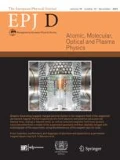Abstract
Selective high-order harmonic radiation can be generated when circularly polarized driving fields interact with single-walled carbon nanotubes. We obtain a gauge-covariant Hamiltonian for electrons confined to a nanotube surface in the presence of a circularly polarized electromagnetic field. Regularized delta-functions are used to approximate the \({\pi }\)-bonds in the nanotube unit cells, and the electron dynamics, in the presence of the field, is analyzed. The high harmonic radiation occurs for incident field intensities high enough to induce significant nonlinearities and chaos in the electron dynamics. Both (5, 5) and (10, 10) armchair nanotubes are considered and the electron quantum dynamics is modeled using Floquet–Bloch theory. The behavior of the quasienergy spectrum, Floquet states, and the electron current are described for varying intensities of the incident field. We show that, for incident radiation with frequency \({\omega }\), the emitted radiation for a (p, p) armchair nanotube will be \((2p\pm 1){\omega }\), \((4p\pm 1){\omega }\), etc.
Graphical abstract









Similar content being viewed by others
Data Availability Statement
“This manuscript has no associated data or the data will not be deposited. [Authors’ comment: This is a theoretical study and no experimental data has been listed.]
References
W. Choi et al., Mater. Today 20, 116 (2017)
N. Briggs et al., 2D Mater. 6, 022001 (2019)
E. Hendry et al., Phys. Rev. Lett. 105, 097401 (2010)
A.R. Wright et al., Appl. Phys. Lett. 95, 072101 (2009)
S.A. Jafari, J. Phys.: Condens. Matter 24, 205802 (2012)
J.L. Cheng, N. Vermeulen, J.E. Sipe, New J. Phys. 16, 053014 (2016)
S. Yamashita, APL Photonics 4, 034301 (2018)
M. Ferray et al., J. Phys. B: At. Mol. Opt. Phys. 21, L31 (1988)
P.B. Corkum, Phys. Rev. Lett. 71, 1994 (1993)
S. Ghimire, A. DiChiara, E. Sistrunk et al., Nat. Phys. 7, 138 (2011)
O. Schubert, M. Hohenleutner, F. Langer et al., Nat. Photonics 8, 119 (2014)
S. Svanberg, A. L’Huillier, C.-G. Wahlstrom, Nucl. Instrum. Methods 298, 55 (1997)
M. Schnürer et al., Phys. Rev. Lett. 80, 3236 (1998)
P. Antoine, A. L’Huillier, M. Lewenstein, Phys. Rev. Lett. 77, 1234 (1996)
M.D. Seaberg et al., Opt. Express 19, 22470 (2011)
R.E.F. Silva et al., Nat. Photonics 12, 266 (2018)
C. Vozzi et al., Appl. Phys. Lett. 97, 241103 (2010)
M.S. Shikakhwa, N. Chair, Phys. Lett. A 380, 1985 (2016)
M.S. Shikakhwa, N. Chair, Eur. J. Phys. 38, 015402 (2017)
O.E. Alon, V. Averbukh, N. Moiseyev, Phys. Rev. Lett. 80, 3743 (1998)
O.E. Alon, V. Averbukh, N. Moiseyev, Phys. Rev. Lett. 85, 5218 (2000)
O. Neufeld, D. Podolsky, O. Cohen, Nat. Commun. 10, 405 (2019)
H. Hsu, L.E. Reichl, Phys. Rev. B 72, 155412 (2005)
H. Hsu, L.E. Reichl, Phys. Rev. B 74, 115406 (2006)
A. Rycerz, Phys. Rev. B 85, 245424 (2012)
D.A. Steck, W.H. Oskay, M.G. Raizen, Science 293, 274 (2001)
D.A. Steck, W.H. Oskay, M.G. Raizen, Phys. Rev. Lett. 88, 120406 (2002)
R. Luter, L.E. Reichl, Phys. Rev. A 66, 53615 (2002)
L.E. Reichl, The Transition to Chaos, 2nd edn. (Spring-Verlag, New York, 2004)
V.I. Arnol’d, Russ. Math. Surv. 18, 9 (1963)
Y. Boretz, L.E. Reichl, Phys. Rev. E 93, 032214 (2016)
R. Saito, G. Dresselhaus, M.S. Dresselhaus, Physical Properties of Carbon Nanotubes, Chapters 2–4 (Imperial College Press, London, 1998)
S. Wang et al., Nanotechnology 17, 634 (2006)
A.D. Bandrauk et al., J. Phys. B: At. Mol. Opt. Phys. 46, 153001 (2013)
R.W. Boyd, Nonlinear Optics, 3rd edn. (Academic Press, Orlando, 2008), p. 28
S.I. Chu, D.A. Telnov, Phys. Rep. 390, 1 (2004)
F.H.M. Faisal, J.Z. Kamiński, Phys. Rev. A 56, 748 (1997)
C. Ortix, J. van den Brink, Phys. Rev. A 83, 113406 (2011)
B. Jensen, R. Dandoloff, Phys. Rev. A 80, 052109 (2009)
Acknowledgements
The authors thank the Robert A. Welch Foundation (Grant No. F-1051) for support of this work.
Author information
Authors and Affiliations
Corresponding author
Additional information
W.A.F. performed the numerical calculations and obtained the numerical results presented in the paper. L.E.R. suggested the research topic and contributed to the theoretical structure of the paper.
Rights and permissions
About this article
Cite this article
Furman, W.A., Reichl, L.E. Selective high harmonics generated from a carbon nanotube. Eur. Phys. J. D 75, 10 (2021). https://doi.org/10.1140/epjd/s10053-020-00012-4
Received:
Accepted:
Published:
DOI: https://doi.org/10.1140/epjd/s10053-020-00012-4


